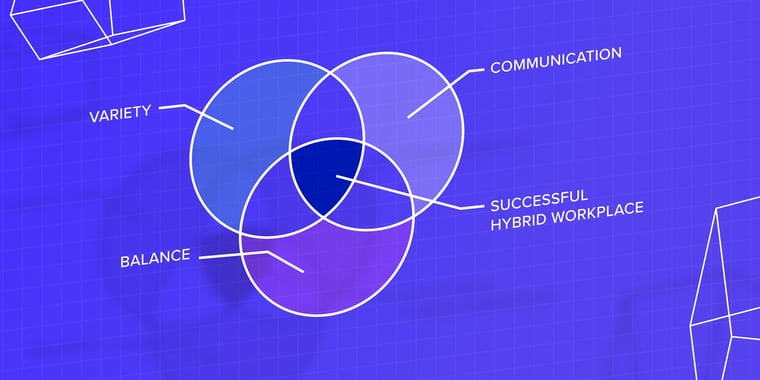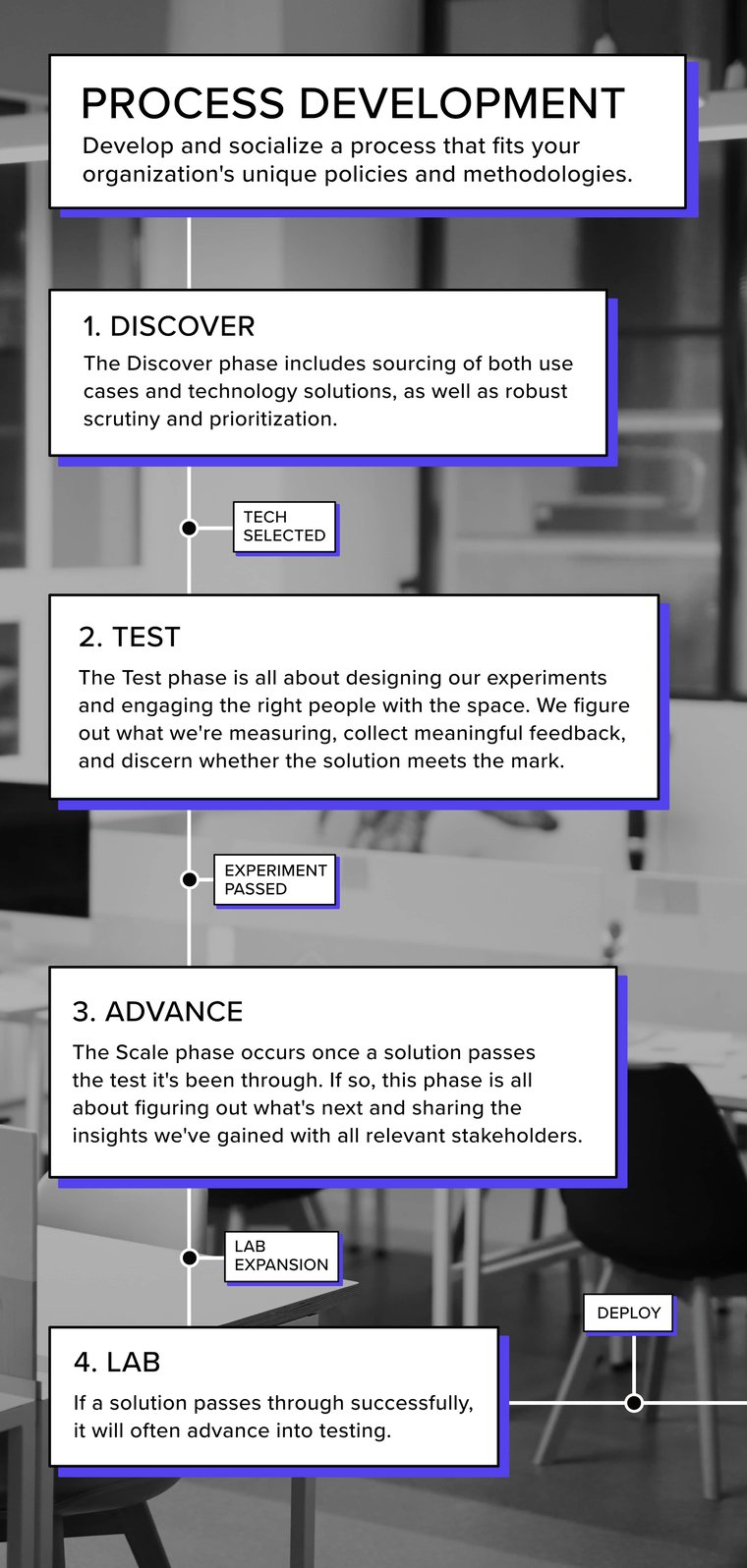Realcomm 2023: The Future Office is Experimental
Takeaways from Realcomm from the InnerSpace team
The team at InnerSpace spent last week engaging with and learning from the best and brightest minds in real estate at Realcomm 2023 in Las Vegas! Realcomm focuses on automated business solutions and state-of-the-art enterprise technologies for the commercial and corporate real estate industry.
With corporate real estate needs for businesses evolving rapidly, the conversations had, and information shared in spaces like Realcomm are crucial to helping InnerSpace support change-makers in evolving their spaces to best suit their teams.
We loved connecting with people in the commercial real estate space. The positive feedback on our product’s ability to meet the growing space utilization needs of this market without pricey and timely hardware installs was a highlight!
Here are our key takeaways and insights from the conference and the panelists:
The value of purpose-built office spaces
Kay Sargent from HOK connected innovation to resilience in a post-pandemic workplace, and we really liked her thoughts on the value of understanding employee behavior and how it relates to how much of an impact hybrid work will have on teams.
Creating incubation spaces for innovation and creativity was also of interest to us in her talk, and we liked this slide, which laid out one way to visualize a return to office plan.

Kay also spoke about the importance of access to leaders and innovators when people are growing in their careers, which points to a need for leaders to be on the ground, supporting their teams.
Measuring productivity
Many Realcomm speakers noted the importance of productivity, but not making it the core focus of your relationship with your staff.
Kay discussed the importance of finding innovative ways to measure productivity, and the need to stop counting online hours as a key metric, and moving towards outcomes and outputs as the most important measure of success. Collaboration and productivity, and how they don’t always connect in the ways one might think they do, made us think too, about the real importance of understanding the reasons people are in the office. A four-day work week as a way to shift from counting hours to measuring quality work was another hot topic.
Challenges with culture in an online and hybrid workplace
During a panel our CEO and Co-Founder, James Wu participated in, Pam Westwater from Quad Real Property Group said, “You can’t have a cocktail party over Zoom and expect it to have the same culture-building impact as an in-person event at the office.”
One of the big takeaways for us was the value in acknowledging that whatever the office culture was before the pandemic, it’s changed now. Building a new office culture, where people feel like they belong and are invested is a crucial part of success in 2023.
Acknowledging that a number of factors, including new staff, hybrid work plans, and return to office plans all shift the culture is an important step in understanding what the culture is, and what organizations would like it to be. Big tech companies like Microsoft, via Teams are taking notice of the value of fresh, innovative technology tools to compliment the hybrid workplace. Especially exciting for the InnerSpace team was how Teams updates and new tools, like Teams Rooms will align with, and potentially complement InnerSpace’s Wi-Fi driven technology for a better hybrid experience.
Maya Setchkova from Cushman and Wakefield shared the importance of making building office culture an intentional part of your business plan. It shouldn’t be an afterthought, or viewed as a less important thing than, say, trainings, or evaluations. It is the glue that keeps people, one of most organizations’ most valuable assets invested and working towards your business goals. Taking the time here will save money and ensure teams are doing their best work.
Intentional time in the office
Arjun Kaicker, Co-Head, Analytics + Insights of Zaha Hadid Architects stressed the importance of finding balance in your office space, and a lot of this came down to being intentional with time spent in the office, from a leadership and individual perspective.
Maybe your office is where your teams collaborate. Maybe it’s where they come to focus. Maybe it’s a place for mentorship. This will be different for every organization, and maybe a combo of a number of these things, or something else entirely. As leaders, you need to know what value your people are taking, and could be gaining from your office space.
The office as a destination
On a panel moderated by Francisco J. Acoba of Ernst & Young (EY), our CEO and Co-Founder, James Wu, along with Jess Joaquin Johnson of HqO, Arjun Kaicker of Zaha Hadid Architects, Maya Setchkova of Cushman & Wakefield, and Pam Westwater of QuadReal Property Group discussed how you can change all the settings in your office, but you won’t be able to compete with the couch for employees who have transitioned and are enjoying working at home unless you thoroughly understand your teams’ space wants and needs. It’s much more than sending a return to office plan and waiting for everyone to show up. Companies need actionable data to understand how get their teams back to the office with purpose.
One of the main takeaways for the InnerSpace team was the importance of today’s office spaces being set up for success. This means spaces for teams to do what they came in to do, be that collaborating, or working with office resources that they don’t have access to at home (that includes face to face time with leaders). These amenities can be softer, like a well-devised plan for people to connect to build culture, or harder, like two monitors, great Wi-Fi, or meeting rooms.

Arjun Kaicker noted the importance of communication, balance, and variety in spaces, and the danger of taking a one size fits all approach for teams. He sees the office as a space where collaboration must be fostered, and understanding how your teams are working now, versus how they worked before is crucial to success.
He noted the importance of meeting your teams on their terms in the office in order to have them work in the most productive way, and the importance of a bridge between working at home and at the office.
The importance of collecting data around when your teams are coming in, but more importantly, how your teams are using the office when they’re in was front of mind in most conversations around the office. Getting a return on a hefty real estate investment requires a thoughtful plan, which requires data that goes beyond people counting (hint, hint, InnerSpace can help you acquire that data, and fast).
Understanding the objects and avoiding a one size fits all solution for hybrid
The grind of the commute came up in a number of talks, and the question of whether people are avoiding returning to the office or despise their commute. If it's the latter, understanding how that obstacle can be overcome is completely different than a challenge with the physical office space.
Arjun also talked about how Zoom is psychologically stressful, whether we realize it or not, and making it part of work, not the crux of work is an important part of employee morale and development. Too much leaning on Zoom robs people of the chance to engage with body language, and the more nuanced parts of communication, which are deeply connected to the human experience.
Ultimately, hybrid may be here to stay, but creating and fostering a space and a culture that understands that and strives to make time in the office the best it can be will help you retain your staff, and encourage them to do their best work, whether they’re on or off-site.
People engagement through office design
Arjun Kaicker made deep connections around the physical build of offices and fulfilled people. He noted the importance of natural light, high ceilings, and optimizing comfort for people when they’re in the office, to foster productivity and create a positive association with the space. Mandating people back to an office that doesn’t support their work isn’t a productive way to run your business, and ultimately will impact office culture in ways that are challenging to rebuild.
This connects closely with our mission at InnerSpace, to ensure our clients have the right data in order to understand the ways people are using, benefitting, and could better engage with the spaces, in order to do their best work.
The value in experimentation
Like in so many scenarios, taking risks and experimentation is a key part of innovation and success. Greg Gallimore, Studio Director, Digital Experience Design Leader, Principal of Gensler spoke a lot about the value in experimenting in his keynote at Realcomm, and the importance of the total experience when it comes to a space. The idea of successful experimenting as long as your key corporate values are honoured in the ideas you pursue was one he mentioned, and we liked the idea of workplace labs, to explore ideas around space use before broader implementation.

Another key takeaway spoke the value of continual experimentation in order to keep innovating. Checking in with an analysis of your space is crucial, but you can’t just do it once in an evolving workplace and expect the results to be the same all the time, especially at this point of heavy flux in workplaces; we have an incomplete picture right now. It’s just a snapshot; teams grow and evolve and you need to keep taking the picture and experimenting to keep teams engaged. This is something InnerSpace feels strongly about too, the value in checking in often and having an evolving plan that connects to data.
The state of commercial real estate
The InnerSpace team left Realcomm feeling recharged and reinvested to our mission. It was validating to see the connections between the work we do and the value we offer with our technology and how it can support the future of office spaces.
Being able to play a crucial role in building offices where people can thrive and do their best work gets us going in the morning, and we’d love to show you how we can get you the data you need, quick and sensor-free, to make sure your people are coming to a radically functional workplace where they can thrive and productivity soars with superior workplace intelligence.
Accurate space utilization data through Wi-Fi?
We'll prove it to you.
See why industry leaders leverage InnerSpace to generate valuable insights that go beyond occupancy.

